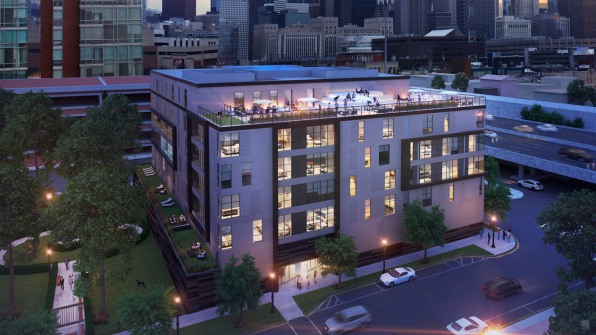Developer PMG is building 3,500 units in Chicago, Brooklyn, and Miami, featuring smaller living spaces and more shared space.

If you live in a new apartment building in Chicago, you might be more likely to spend a typical night downstairs at a mixology or bike repair class–or sitting with neighbors by a fire pit, watching your dogs run around the building’s dog park–than in your apartment watching Netflix.
“I would say it’s the most social building I’ve ever seen,” Daniel Ellch, a tenant, tells Fast Company. That’s by design: The developer, Property Markets Group or PMG, is entering the coliving market, offering slightly smaller private spaces and prioritizing common areas built to foster interaction. It’s the path followed by WeLive, Ollie, Common, and other startups, but, as a large developer, PMG is going bigger, with 3,500 units planned in the next five years, built and operated by a new branch of the company called PMGx
.“It was really the company trying to pull back and look at all of the societal macro trends and saying, if we take out everything that is sort of institutionally known about creating a rental building, what’s the product that makes the most sense for modern young professionals?” says Brian Koles, director of brand and tenant experiences at Property Markets Group. “People are more transient, they have a lot of debt, people are moving to cities and want to own less . . . there’s a shift in values toward experience over ownership.”
PMG, which is headquartered in New York City with offices in Miami and Chicago, has completed 85 residential buildings in New York and more than 150 real estate projects in the United States since it launched in 1991. The company bought the land for each of the new PMGx buildings, and is building them from the ground up.
At the company’s first building, 120 units in Chicago’s Logan Square neighborhood, someone can choose to rent a bedroom and private bath in a larger three- or four-bedroom apartment with a fully furnished common space and kitchen; all they might need to buy is a bed. The building also has micro-studios. A 464-unit building in Miami will follow in 2018 along with a second building in Chicago, and later buildings in Brooklyn, Denver, and other major markets.
If most early attempts at coliving used existing buildings–either hacker house-style conversions of single family homes, or adaptations of existing apartment or office buildings–the new building was designed from scratch for this purpose.
“Adaptative reuse–changing an existing product–is incredibly expensive and inefficient,” Koles says. “Trying to reverse engineer a vision for a building is also really hard because it’s literal walls and a lot of infrastructure in the way. We have the advantage if we start from the pile of dirt and we get to say, What can we build here that is going to be exactly what we want it to be? And we have the resources to do it at a larger scale than anyone else.”
The rest of the story can be found here: https://www.fastcompany.com/40420420/coliving-isnt-just-for-startups-a-giant-developer-is-building-upscale-dorms-for-adults